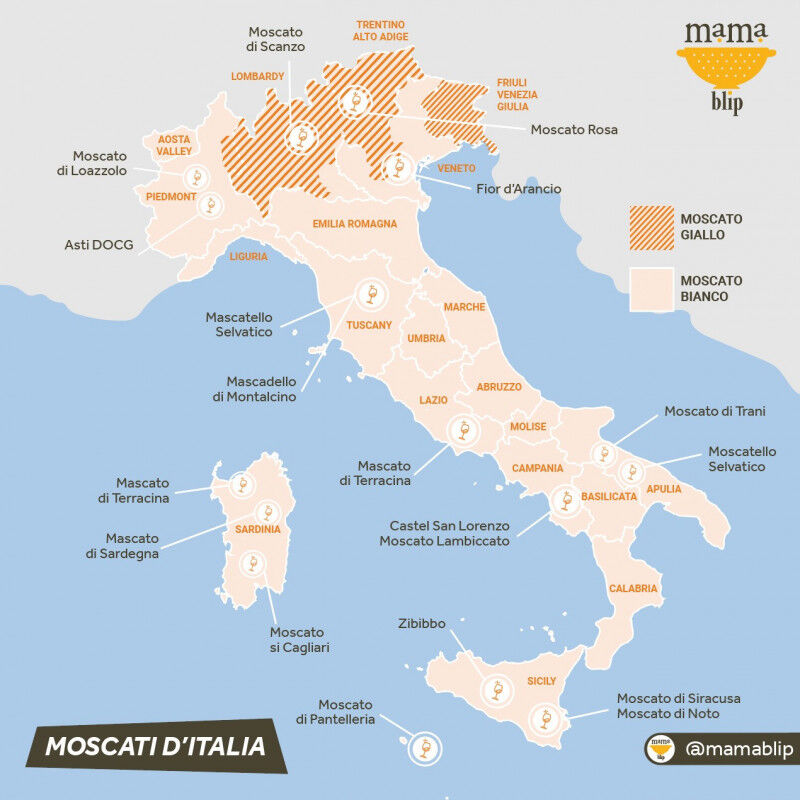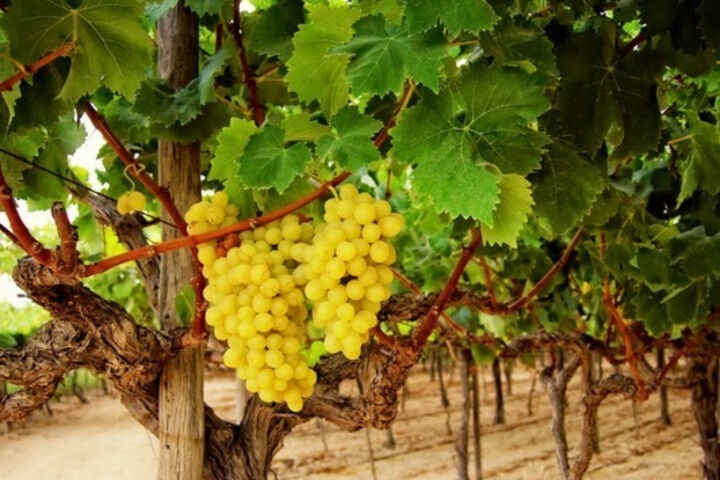Moscato in 30 seconds
- The Moscato (Muscat) family is very large with over 200 types.
- Researchers say it’s the oldest Vitis vinifera grape.
- It appears under numerous names around the globe.
- The finest Moscato grape is Muscat Blanc à Petits Grains (known in Italy as Moscato Bianco).
- It has peach, floral, musk, and grape aromas/flavors.
- Moscato typically has medium acidity.
- Moscato Bianco makes the much-loved low-alcohol, sweet Moscato d’Asti from Piedmont.
- In Italy, some Moscato grapes produce dry styles (Muscat de Chambave from the Aosta Valley), passito (Calabria), and fortified styles (Sardinia).
- This grape appears in DOC, DOCG, and IGT wines.
Where does moscato wine come from?
Moscato is the name for a huge family of grapes both black and white used in still and sparkling wines as well as dry to sweet styles. This multi-faceted grape is one of the most ancient cultivars in existence and grape researchers regard it as the grand-daddy of all Vitis vinifera varietals.
Learn about Moscato
Across the hundreds of Moscato types, a powerful musky floral aroma is the unifying characteristic and is a signature feature in Moscato d’Asti. This lightly sparkling wine from Piedmont is made from the Muscat Blanc à Petits Grains variety and is loved for its fresh peach and white floral notes plus gentle sweetness and perlage.
Muscat Ottonel, Muscat of Alexandria, Moscato Nero, and Moscato Rosa are other widely-cultivated varieties of Moscato.
What does Moscato taste like?
The aromas, flavors, and features of Moscato are very distinct. This grape displays delicate florals, honey, stone fruit, and musk. Odd as it may sound, Moscato is also very “grapey”.
Still or sparkling, Moscato typically makes light-bodied wines with medium acidity.
Moscato Wine Styles
Moscato is a versatile cultivar that appears in still, sparkling, sweet, and fortified wines. Moscato Bianco is the grape in lightly sparkling Moscato d’Asti, while Muscat de Chambave from the Aosta Valley is dry and passito style wine from Calabria is still and off-dry. Sardinia is famous for its fortified style of Moscato. Still, sweet Moscato Rosa wines are popular in Trentino-Alto Adige.
What foods go well with Moscato?
Moscato is one of the most food-friendly wines in Italy because of its fruit and floral notes. Whether sparkling or still, these characteristics make it an ideal wine for cuisine that can often be difficult to complement. When matching Moscato with food, the key to success is its aromatic profile and degree of sweetness.
Moscato Food Pairing
Sparkling Moscato
- Appetisers: Spicy charcuterie; Indian finger food.
- Entrées: Light, spicy Asian cuisine.
- Desserts: Light fruity pavlova; almond cake; tiramisu.
- Cheese: White Stilton; Goat cheese.
Dry Moscato
- Appetisers: Crudités; oysters.
- Entrées: Salads; sushi; tempura vegetables; salmon; seafood.
- Dessert: Fresh fruit salad; pannacotta.
- Cheese: Goat cheese; Pecorino
Top Moscato Appellations/ Areas
In Italy, the most prominent Moscato is Muscat Blanc à Petits Grains or Moscato Bianco. It’s the fourth most widely planted white grape in the country and appears across 17 DOCs and DOCGs. Perhaps its most famous wine is Moscato d’Asti DOCG from Piedmont.
Other Moscatos of note include Muscat de Chambave DOC from the Aosta Valley and, in Calabria, an IGT passito style of Moscato. Lombardy makes spumante, fortified, and passito styles of Moscato.
In just about every Italian wine region there’s at least one style of Moscato wine made from white, red, or black-skinned grapes.
What is the origin of Moscato wine?
The roots of Moscato are lost in time so, unsurprisingly, there are a few theories as to its origins. Many researchers believe it originates in ancient Persia and Egypt while others are adamant that it was first farmed in ancient Greece and Rome.
Wine production was an important activity in each of these civilizations and references to sweet styles of wine appear in numerous classical texts. However, there’s no specific mention of the Moscato grape.
In 1230, an English Franciscan scholar mentioned a sweet grape in a wine tract. A century later, this work’s French translation includes a mention of "vin extrait de raisins muscats".
Wherever it hails from, Moscato’s unique aromas and flavors make it a welcome addition to the world of Vitis vinifera!
How is Moscato made?
Moscato d’Asti is made with a process known as the Asti method. Grape juice is chilled and stored until ready for alcoholic fermentation in pressurized steel tanks. Fermentation stops at around 7% alcohol level when the winemaker chills the wine. These results in residual sugar giving this lightly sparkling wine its sweetness.
Dry Moscato is made with standard winemaking methods, but the vigneron may avoid oak to preserve the fruity floral notes that give Moscato its unique profile.
Fortified Moscato is typically a result of robust maceration for flavor and color intensity as well as the addition of a powerful spirit in order to increase the alcohol content. Fortified may see oak treatment for extra structure.





